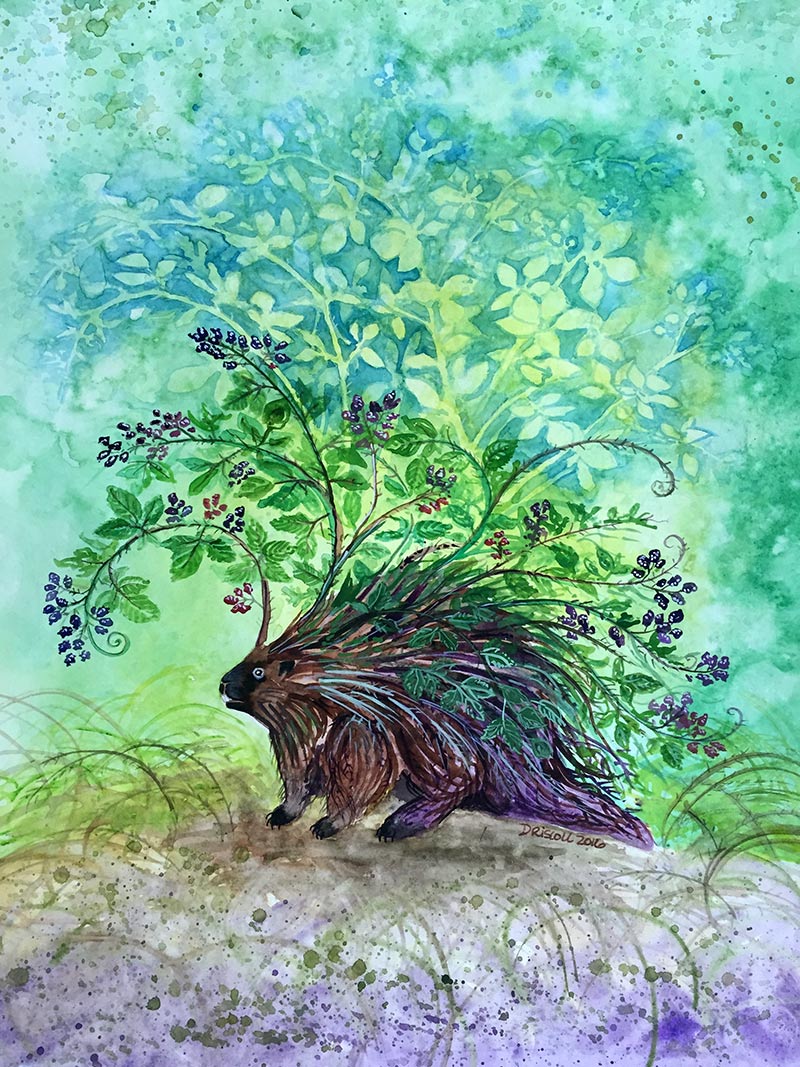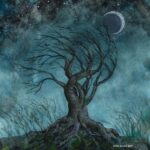I am excited to announce that my 2018 Mount Haemus Award article, titled “Channeling the Awen Within: An Exploration of Learning the Bardic Arts in the Druid Tradition” has been released on OBOD’s website (a better-formatted PDF is at the bottom of the page; I suggest downloading and reading that). In 2020, I will travel to the UK to deliver a talk tied to the paper itself, as every four years, OBOD offers a Mount Haemus lecture for the four most recent scholars. Every eight years, OBOD publishes a volume, and the next volume will also include this paper. Given this incredible honor–and the fact that the project is now finally finished (whew!)–I wanted to take a bit of time today to talk about the project, what I learned, and how I hope it can help others.
What I Learned

This project was probably the most fun I have had as a learning researcher–I surveyed over 250 druids and conducted in-depth interviews with 15 druids from all around the world. I was able to connect with so many interesting people who adored the bardic arts, or who wanted to start a bardic practice, or who dabbled. I got to know them, as people, as druids, as practitioners of the bardic arts. The project really took on a life of its own; I was able to delve deeply into the lived experiences of these druids and understand a lot more about how creativity and the bardic arts worked for them, but also how they discovered druidry, went deeper into their druid paths, and more.
I would say the most important thing I learned is that it takes a tremendous amount of courage to pick up a bardic art, especially if you haven’t done it before or grown up with it, and this is due to the presence of so much negative cultural baggage surrounding “talent” (which I discuss both in the Mount Haemus paper as well as in my bardic arts series on this blog). But for those who were able to take that step forward, knowing they wouldn’t be good at it when they started–the rewards were incredible. I didn’t have the space to share the countless stories about just how important the bardic arts were for druids around the world. For some, they described it as their very breath, the thing that gets them up in the morning, the thing that helps them make sense of the world around them. People found deeply rich and meaningful spiritual rewards in their bardic practices–irrespective of how “good” or “talented” they felt they were. In fact, for many dedicated practitioners, it wasn’t about the product at all–it was about the act of creating. In the same way that doing a meditation isn’t about the act of meditation, it is about the spiritual benefits and calm one feels afterward–the daily living benefits. The bardic arts were the same–it was less about producing something good, and more about simply creating/dancing/singing/knitting/playing music, or whatever else it was. It didn’t matter what it was, but it was deeply spiritual and beneficial.
The second major finding was the power of community. The Eisteddfodau, in particular, was deeply meaningful for those people who had access to them, even once a year at a major druid gathering. I had attended these for years and had certainly enjoyed them, but for many, they were positively transformational for many and helped the community, and individuals, overcome some of the challenges we face when taking up bardic arts.
After doing this research, I now understand how critically important the bardic arts are to the druid tradition. So important, I would argue, that it should be of prime concern for us as a tradition to work to promote them, to reduce the negative language surrounding talent that disempowers people from taking them up or pursuing them, and that we find ways of encouraging people to embrace the bardic arts. To make them as central to our tradition as they are to the individuals who practice them.
A final thing I discovered, which was outside of the scope of the paper, so I’ll just share it here, was the incredible and varied ways in which people stumbled upon or came into the druid tradition. Finding druidry was an act, for many, of coming home. Of finding a term to describe oneself, a term that had been lacking. In many cases, it was like they stumbled upon this great treasure, a spiritual path that fit them and began walking it. The cycle of the year, the cycle of the seasons, the channeling of awen–these were deeply moving aspects for druids. It was amazing to hear so many “coming home” stories of people who were proud to call themselves druids, to learn that druidry was a thing, and to seek their spiritual solace and joy in the living earth. What a wonderful and delightful tradition we belong to!

Why this topic?
Now that I’ve shared some of the major findings and things that excite me, I also wanted to take a few minutes to share some of what drew me to this topic. This project was born out of a few places. First, and foremost, druidry is quite unique in its celebration of the bardic arts as part of our spiritual practice. This is foreign to folks, especially those coming out of Abrahamic religions. I remember one person saying to me, “what, so you can paint and that’s spiritual work?” and I was like yes, I honor nature, and painting her is part of my spiritual work. So for non-druids, wrapping one’s head around that is difficult. But once you have wrapped your head around it, it becomes an extremely powerful experience–creativity as spirituality. In my Mount Haemus piece, I shared stories from my participants about their deep spiritual relationship with their bardic arts. I, too, had experienced a powerful spiritual practice in my artwork and in my flute playing, and I wanted to discover how more people may be able to have similar experiences. Part of the impetus for doing this particular project was rooted in that joy that I discovered as I walked the druid path and brought together my love of nature and my love of creating things. I wanted to know how the bardic arts functioned for others and the journeys that people took.
A second motivating factor for why I wanted to do the project was my mentoring work with the AODA, people who are working on the AODA’s first, second, or third degrees have some choice. They can choose to pursue bardic arts (which are any of the creative or performative arts: music, dance, visual arts, fine crafts, etc); they can choose to pursue the ovate arts, through the study and exploration of nature; or they can choose to pursue the druid arts, which would involve magic, divination, astrology, mysticism, and more. When people make their choice or talk to me about their choice, they often qualify reasons why they didn’t make another choice: “Oh, I’ll never be a good artist.” Or “Oh, I can’t sing at all.” It was sad to me, as someone who has dedicated so much of my life to the study of all three branches of druidry, to see people who had already believed they were going to fail before they even began. I knew that this came from a lot of sources, some of which I wrote about in terms of my participants for the Mount Haemus piece and some of which I wrote about on my blog in my “Taking up the path of the bard” series in terms of my own bardic practice. But I wanted to explore this moe.
A third reason was in people’s reactions to my own artwork–after 13 years of dedicated painting and lots of mistakes, I have continued to be extremely frustrated when people attributed all that I had achieved as an artist to “talent.” It happens literally anytime I posted a photo on social media–people coming in saying, with the best of intentions, meaning to be complimentary, “you are so talented, I could never do that.” And what frustrated me was that it wasn’t talent, it’s not like I picked up a paintbrush yesterday and created a masterpiece. Rather, it was a ton of hard work and dedication to my craft, expert feedback, study, and challenging myself in new directions. I wrote about this more specifically in my post on the bardic arts surrounding “practice makes perfect.” That post was motivated entirely by that situation. I was so pleased to learn in the study that for druids, it was about the process of creating something and the tie to spirituality, rather than the product that was to be something commodified.
Finally, I did the project because I had professional expertise in the area of learning. In my mundane life, I’m a professor and learning researcher, and for over a decade, I have been studying in various forms how people learn to write (particularly in academic contexts) and how they develop as writers over time. I already understood learning and developmental theories that might support the project, I had used qualitative and quantitative research methods for years (and taught others how to use them at the doctoral level) and so it was already within my expertise as a scholar to work on a project in that regard. And I thought there might be something interesting that my particular expertise could contribute to the broader druid tradition. And certainly, I think there was!

So this was a very exciting and fulfilling project for me, both as a druid, and as a scholar. In truth, I am so proud of our community: proud of the tradition we continue to develop, proud of how we’ve overcome challenges to become bards, and so delighted to have gotten to know so many more druids in the course of this project.
Well, what are you still doing here? Go over to the OBOD site and read the piece if you are interested!




Congratulations!
Thank you!
Reblogged this on Paths I Walk.
Thanks, Dana. Your writing and painting (and gardening!) are extremely inspirational for me.
Regards,
Sunny Bee
Thank you, Sunny Bee!
Reblogged this on Three Rivers.
Thank you for the reblog!
Thank you for sharing your wonderful project with us! Congratulations on receiving the Mount Haemus Award!
Reblogged this on Rattiesforeverworldpresscom.
I enjoyed having a bit part in this process. Congrats!!!